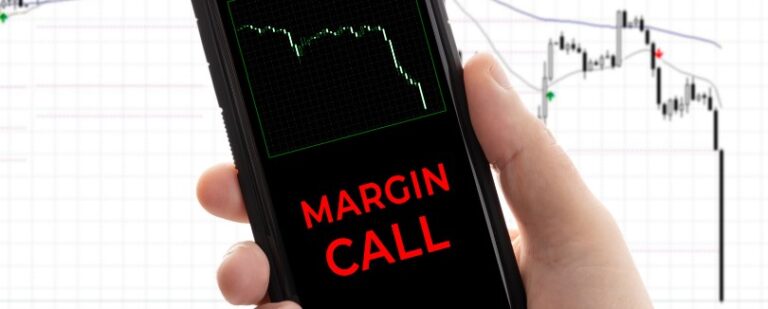Forex margin call is a term frequently encountered in leveraged Forex trading. It occurs when the account equity drops below a certain percentage, leading to the liquidation of open positions.
In this article, we will delve into the details of Forex margin call, with key takeaways including:
- The purpose of margin call is to safeguard both traders and brokers from further losses.
- Forex margin call is based on the margin level – determined by dividing the account equity by the used margin.
- Used margin represents the deposit required to open a position and remains frozen until the position is closed.
- Margin call levels vary among brokers, with 25%, 50%, and 100% being the most common thresholds.
Forex Margin Call Meaning
The term “margin call” inherently suggests its meaning itself: a call for additional margin to maintain a position. However, unlike the process in the futures/stock market, where traders are given an opportunity to deposit additional funds, in leveraged Forex trading, a margin call leads to immediate liquidation of open positions.
A Forex margin call is triggered when the account equity falls to a certain percentage of the used margin. The specific percentage may vary among brokers, with common levels being 25%, 50%, and 100%.
Why Forex Margin Calls Occur
Despite traders experiencing losses from Forex margin call, the primary purpose of margin call is to protect them from further losses. Additionally, margin calls also serve to safeguard Forex brokers.
1). Protect Traders from Further Losses
In leveraged trading, P&L are based on the value of positions, which can significantly exceed traders’ capital. For instance, with high leverage, a trader can open a $100K position with just $100 in the account. This high-value position can result in substantial P&L fluctuations within seconds.
Consequently, traders may quickly lose their capital, leading to negative equity, especially in volatile market conditions. Margin call is implemented to mitigate this risk, reducing the likelihood of accounts falling into negative balances.
2). Protect Brokers from Additional Cost
In the event of a negative balance in traders’ accounts, Forex brokers will either try to collect the deficit from the traders or absorb the deficit themselves.
Either way, there will be additional costs incurred for Forex brokers. Margin call helps reduce the chance for traders to go into the negative, consequently also lowering the brokers’ risk of dealing with such cases.
What is Used Margin in Forex
To understand margin call better, let’s introduce three key terms in leveraged Forex trading: Used Margin, Free Margin, and Margin Level, as depicted in the most popular Forex trading platform Metatrade 4(MT4):
We will start with used margin, displayed simply as “margin” on the MT4 platform, represents the margin utilized by the open positions. It serves as the anchor that account equity relies on to determine the occurrence of a Forex margin call.
Once a position is opened, its used margin becomes frozen and unavailable until the position is closed. The calculation of used margin is determined by three factors:
- Lot size
- Leverage
- Base currency(the currency on the left side of the traded pair)
It can be calculated using the formula in below,
Used margin = (Lot size × 100,000 Base currency) / Leverage
For example, with the leverage of 1:500, the margin used for 100,000(1 lot) USDJPY is 200 USD, while the used margin for 1 lot EURUSD is 200 EUR.
Usage of Free Margin in Forex
Free margin represents the available margin in the trading account, which can be utilized to manage floating Profit and Loss (P&L) and to open new positions. The free margin definition in forex is as simple as follows:
Free margin = Equity – Used margin
Free margin fluctuates in line with the P&L of open positions. In the event of a positive floating P&L, the free margin increases, whereas in the case of a negative floating P&L, the free margin decreases.
Free margin serves as the primary funds for managing negative floating P&L. In other words, the extent of price setbacks a trader can withstand depends on the free margin available. Therefore, while Forex margin calls are based on used margin, it’s the free margin that holds greater importance in managing Forex trading risk.
Understanding Forex Margin Level
The Forex margin level, displayed as a percentage on the MT4 platform, indicates the ratio of equity to used margin. A margin call is triggered when the margin level drops to the margin call level set by the broker.
The margin level is calculated using the following formula:
Margin level = (Equity / Margin) × 100%
This calculation is straightforward, allowing traders to assess margin call risk by monitoring the margin level on the MT4 platform at any time.
Determining a safety margin level depends on various factors, primarily the position size and the capital size. In general, a higher margin level is preferable as it indicates a lower risk of triggering a margin call.
However, traders should carefully evaluate their individual circumstances and risk tolerance to determine the safety margin level for their trading strategy.
Different Margin Call Levels
As mentioned, margin call level can vary among brokers. Let’s consider a scenario where a trader gets margin call for a one lot long position on USDJPY with 1:500 leverage and an initial equity of $1,000, what’s different between 50% and 100% margin call levels?
| 50% Margin Call Level | 100% Margin Call Level | |
|---|---|---|
| Used margin | $200 | |
| Free margin | $800 | |
| Max drawback* | $900 | $800 |
| Equity after margin call | $100 | $200 |
Max drawback refers to the losses that will trigger a margin call, let’s examine the pros and cons of each margin call level:
50% margin call level
- Pros: Higher tolenrance for floating losses, providing traders with the opportunity to recover if the market reverses.
- Cons: Results in greater losses after a margin call if the price fails to rebound.
100% margin call level
- Pros: Fewer losses after margin call.
- Cons: Less opportunity to recover from losses.
The result may be different for specific cases, however, overall, there would be no significant difference. Some days you may experience greater lesses due to a lower margin call level, while on other days, you may benefit from it.
Margin Call on Multiple positions
Now that we understand force liquidation occurs during a Forex margin call, what will happen if we hold multiple positions when a margin call occurs? Depending on the rules of your broker, there are two approaches, and we will explain them with the same example in below:
1). Closing Out All Positions Together
This approach is straightforward. Regardless of the number of open positions held, all of them will be liquidated at the same time. Theoretically, the remaining account equity after the margin call will be approximately equal to or slightly lower than the used margin for all the liquidated positions.
In our example, both the USDJPY and EURUSD positions will be liquidated at the same time, and the account equity remaining after the liquidation will be approximately ($300 + $220) / 2 = $260.
2). Closing the Position with the Largest Losses
This approach is more complex, in our example, the USDJPY position incurs larger floating losses than the EURUSD position, resulting in its liquidation first. Upon liquidation of the USDJPY position, 50% of its used margin, which is $150, will be released to the free margin.
As a result, the margin level of the remaining EURUSD position increases to (110 + 150) / 110 = 236%, which is above the 50% margin call level. This means that the EURUSD position becomes safe again, and it won’t be liquidated unless it incurs another $205 in losses.
However, if the market continues moving unfavorably and triggers the margin call for the EURUSD position, what will remain after the margin call is only $220 / 2 = $110.
How to Reduce Margin Call Risk
As the financial market is inherently unpredictable, it’s impossible to completely avoid margin call. However, there are several strategies traders can employ to mitigate the risk of encountering margin call.
1). Control Position Size
The level of risk exposure is directly influenced by the size of open positions. Larger positions carry higher margin call risks. Therefore, traders should carefully assess and determine the appropriate position size that aligns with their equity and risk tolerance.
Leveraged Forex trading is a form of financial trading, not gambling. For traders who want to open an one lot position with only $100 equity, a casino might be more suitable.
2). Strickly Stick to Stop Loss
Many traders, especially when facing significant floating losses, often delay or even remove their stop loss orders entirely, hoping that the market will eventually turn around in their favor. Unfortunately, this approach often leads to margin calls and even greater losses for most traders.
You might win occasionally, but ultimately, such behavior will only result in larger losses overall. It’s crucial to stick to your trading plan and stay away from trading when you cannot understand the market dynamics. Otherwise, it becomes more akin to gambling rather than financial trading.
3). Avoid Holding Positions Over the Weekend
The Forex market is closed on weekends, however, certain events occurring during the weekend can lead to significant market gaps when trading resumes on Monday. These large market gaps have the potential to trigger margin calls for traders.
Below is an example on GBPJPY, the market opened 95 pips higher than last week’s closing price. A movement of 95 pips on GBPJPY equates to approximately $700 in losses for a one-lot short position
4). Stay Away from News Trading
Important economic news releases such as Non-Farm Payroll, CPI, and Central Bank Rate Decisions have the potential to create significant volatility in the market within a short period. These events can also lead to market gaps, especially when unexpected outcomes occur.
As a result, many experienced traders choose to avoid trading during such high-impact news events to minimize the risk of adverse market movements and potential margin calls.




